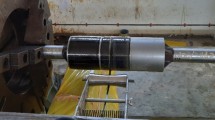Abstract
Composite materials are promising candidates as structural materials and substituting metals in extensive applications. Shafts are used in aerospace and automotive structures and hence replacing conventional shafts with composite material shafts is a viable option. Hollow shafts can be manufactured using filament winding technology employing hoop and helix winding layers. Filament winding technology offers several advantages such as continuous filaments through structure and capability for continuous manufacturing. Previously researchers have investigated composite shafts; however, this research elaborates the significance of type of winding layer on torsional characteristics. This paper reports the effects of carbon fiber winding layer on torsional characteristics of filament wound composite hollow shafts. Shafts were manufactured using filament winding technology with continuous carbon fiber roving and epoxy matrix material and tested using the torsional testing machine. The finite element (FE) simulations have been carried out with a general purpose commercial FE code, ABAQUS, to demonstrate shafts in torsional loading. The results revealed that values from torsional test correlate with developed finite element model. It was concluded that helix winding layer offers high hardness and more resistance to torsional forces as compared to hoop winding layer in filament wound composite shafts.












Similar content being viewed by others
References
Harris B (1991) A perspective view of composite materials development. Mater Des 12(5):259–272
(2000) Composite golf shaft is more accurate. Reinforced Plastics 44(11). https://doi.org/10.1016/S0034-3617(00)80066-1. http://www.sciencedirect.com/science/article/pii/S0034361700800661
Kim H, Lee D (2007) Design and manufacture of stainless steel/carbon epoxy hybrid shaft for cleaning large LCD glass panels. Compos Struct 80(2):279–289
Lee D, Yun Hwang H, Kook Kim J (2003) Design and manufacture of a carbon fiber epoxy rotating boring bar. Compos Struct 60(1):115–124
Chung D (1994) Carbon fiber composites. Butterworth-Heinemann, Boston
Newcomb B (2016) Processing, structure, and properties of carbon fibers. Compos A Appl Sci Manuf 91:262–282
Chung D (2017) Processing-structure-property relationships of continuous carbon fiber polymer-matrix composites. Mater Sci Eng R Rep 113:1–29
Henry T, Bakis C, Miller S, Smith E (2015) Multi-objective optimal design of composite rotorcraft driveshaft including strain rate and temperature effects. Compos Struct 128:42–53
Rao BJP, Srikanth D, Kumar TS, Rao LS (2016) Design and analysis of automotive composite propeller shaft using fea. Mater Today Proc 3(10):3673–3679
Marsh G (2001) Composite ship shafts shape up. Reinf Plast 45(11):32–36
Cho D, Lee D, Choi J (1997) Manufacture of one-piece automotive drive shafts with aluminum and composite materials. Compos Struct 38(1–4):309–319
Badie M, Mahdi E, Hamouda A (2011) An investigation into hybrid carbon/glass fiber reinforced epoxy composite automotive drive shaft. Mater Des 32(3):1485–1500
Lee D, Sung Kim H, Woon Kim J, Kook Kim J (2004) Design and manufacture of an automotive hybrid aluminum/composite drive shaft. Compos Struct 63(1):87–99
Mutasher S (2009) Prediction of the torsional strength of the hybrid aluminum/composite drive shaft. Mater Des 30(2):215–220
Shokrieh M, Hasani A, Lessard L (2004) Shear buckling of a composite drive shaft under torsion. Compos Struct 64(1):63–69
Montagnier O, Hochard C (2013) Optimisation of hybrid high-modulus/high-strength carbon fibre reinforced plastic composite drive shafts. Mater Des 46:88–100
Reddy P, Nagaraju C (2017) Weight optimization and finite element analysis of composite automotive drive shaft for Maximum Stiffness. Mater Today Proc 4(2):2390–2396
Pater Z, Gontarz A, Tomczak J, Bulzak T (2015) Producing hollow drive shafts by rotary compression. Arch Civil Mech Eng 15(4):917–924
Bert C, Kim C (1995) Analysis of buckling of hollow laminated composite drive shafts. Compos Sci Technol 53(3):343–351
Capela C, Ferreira J, Febra T, Costa J (2015) Fatigue strength of tubular carbon fiber composites under bending/torsion loading. Int J Fatigue 70:216–222
Sevkat E, Tumer H, Halidun Kelestemur M, Dogan S (2014) Effect of torsional strain-rate and lay-up sequences on the performance of hybrid composite shafts. Mater Design 60:310–319
Tariq M, Nisar S, Shah A, Akbar S, Khan M, Khan S (2017) Effect of hybrid reinforcement on the performance of filament wound hollow shaft. Compos Struct 184:378–387
Sevkat E, Tumer H (2013) Residual torsional properties of composite shafts subjected to impact loadings. Mater Des 51:956–967
Misri S, Sapuan SM, Leman Z, Ishak MR (2015) Torsional behavior of filament wound kenaf yarn fiber reinforced unsaturated polyester composite hollow shafts. Mater Des 65:953–960
Siddiqui N, Khan S, Kim J (2013) Experimental torsional shear properties of carbon fiber reinforced epoxy composites containing carbon nanotubes. Compos Struct 104:230–238
Porter M, Meraz L, Calderon A, Choi H, Chouhan A, Wang L, Meyers M, McKittrick J (2015) Torsional properties of helix-reinforced composites fabricated by magnetic freeze casting. Compos Struct 119:174–184
Mendonça W, Medeiros E, Pereira A, Mathias M (2017) The dynamic analysis of rotors mounted on composite shafts with internal damping. Compos Struct 167:50–62
Abu Talib A, Ali A, Badie M, Azida Che Lah N, Golestaneh A (2010) Developing a hybrid, carbon/glass fiber-reinforced, epoxy composite automotive drive shaft. Mater Design 31(1):514–521
Bang K, Lee D (2002) Design of carbon fiber composite shafts for high-speed air spindles. Compos Struct 55(2):247–259
Velosa J, Nunes J, Antunes P, Silva J, Marques A (2009) Development of a new generation of filament wound composite pressure cylinders. Compos Sci Technol 69(9):1348–1353
Beer F, Johnston E (1981) Mechanics of materials. McGraw-Hill, New York
Rivin E (2010) Handbook on stiffness and damping in mechanical design. ASME Press, New York, p 39
Sarkar B (2003) Strength of materials. Tata McGraw-Hill, New Delhi
Acknowledgements
The authors thank the technicians at PN Engineering College, NUST, for technical support in manufacturing and testing of samples. Furthermore, we would like to thank our colleagues for provision of FEA expertise.
Author information
Authors and Affiliations
Corresponding author
Additional information
Technical Editor: Márcio Bacci da Silva.
Rights and permissions
About this article
Cite this article
Tariq, M., Nisar, S., Shah, A. et al. Effect of carbon fiber winding layer on torsional characteristics of filament wound composite shafts. J Braz. Soc. Mech. Sci. Eng. 40, 198 (2018). https://doi.org/10.1007/s40430-018-1099-3
Received:
Accepted:
Published:
DOI: https://doi.org/10.1007/s40430-018-1099-3




